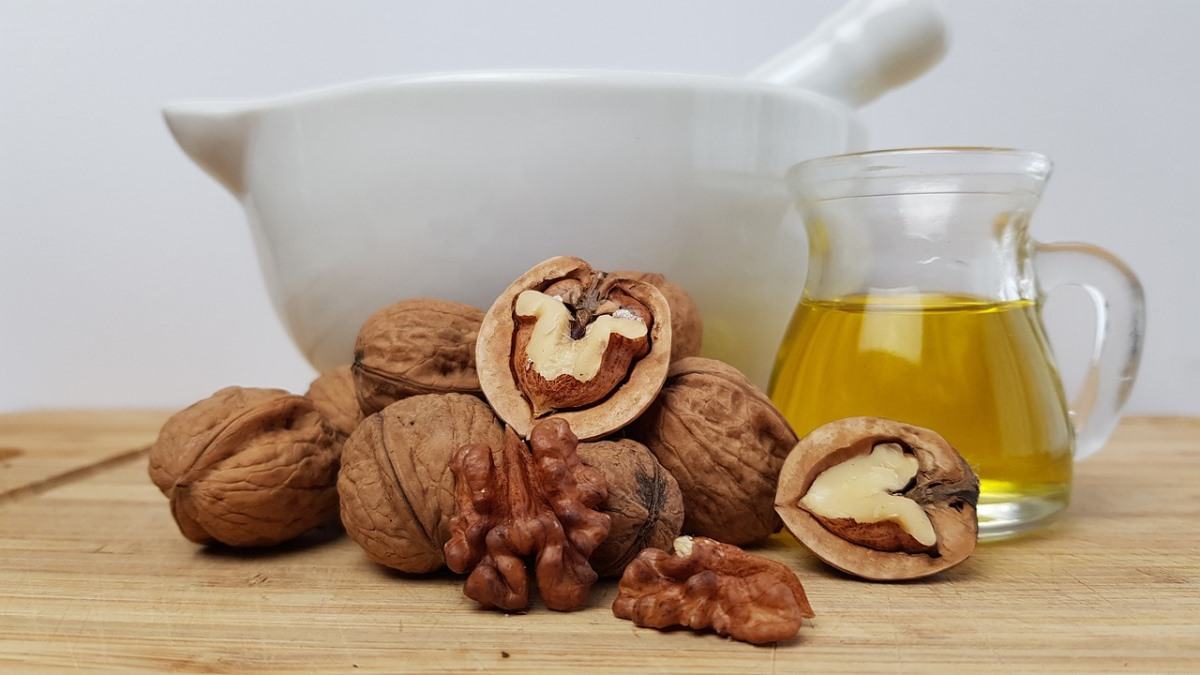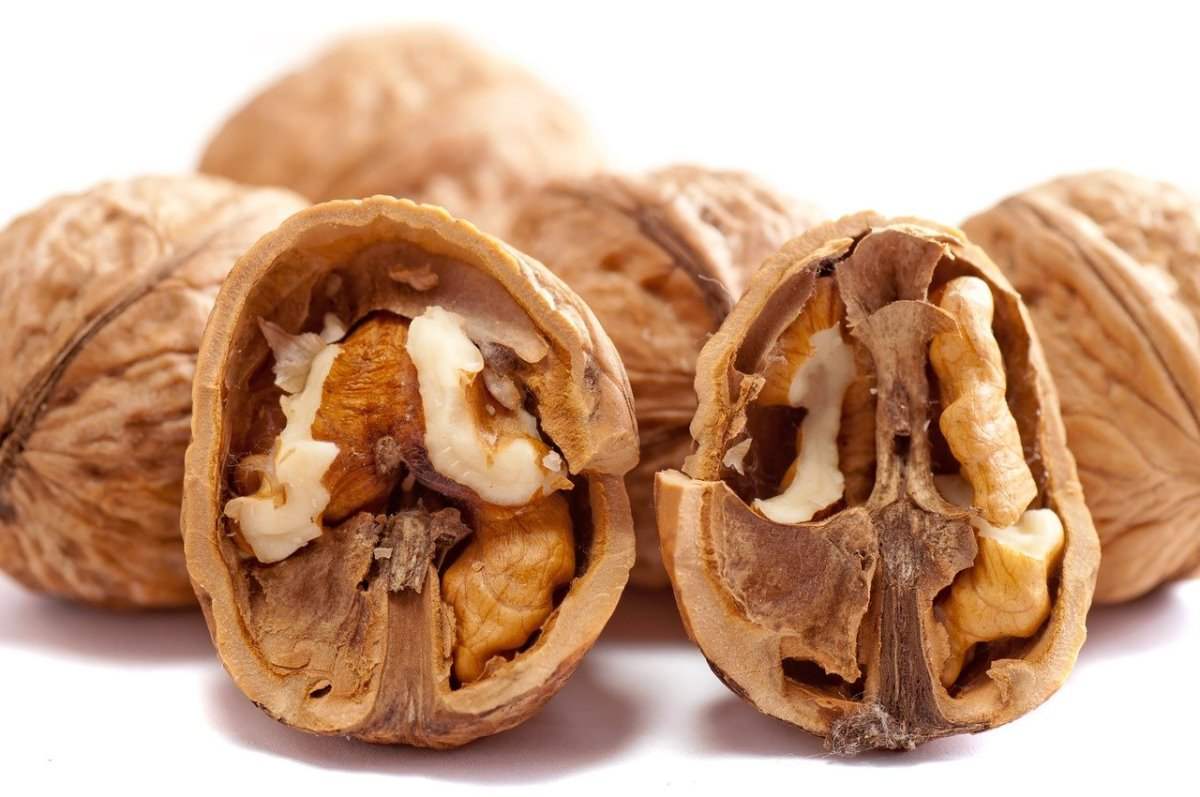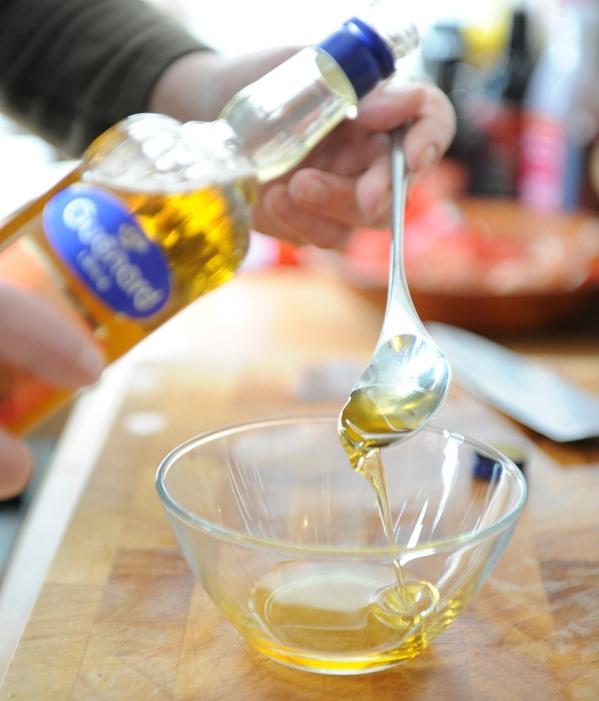Introduction to Walnut Oil Project Report, Business Plan: Hello friends, do you want to know about the walnut oil project report and manufacturing business plan? then you are in right place. Walnut oil is obtained from walnut kernels which include around 60% fat content after being dried. The oil is manufactured using either cold-pressing, hot-pressing, or chemical extraction. Usually, the cold-pressed method is widely used which gives a high-quality oil after proper refining or filtration. Oils of low quality (obtained after a process like extraction or hot-pressing) are even refined to remove foreign and bitter materials. First, the nuts are obtained from their outer shells and kept to dry. For getting a high yield with appropriate aroma and flavourful oil, the walnuts are often roasted before the pressing step. For a cold-pressing, the nut kernels are careful – avoid any heat input – added into a screw press and then de-oiled. Later, the oil is filtered in several steps to separate the lees and turbidity components. For a hot-pressing, the oil is acquired only after a substantial heat input. A hot-pressing will use mechanical pressure using a screw press. Later, it is refined for separating undesirable stuff. The end product – oil is comparatively neutral in odor and taste, with a long shelf life. The oil can also be removed from the walnuts by chemical extraction that employs organic solvents. The solvent is later removed after second heating, and followed by the common refining process.
Walnut Oil Project Report, Manufacturing Business Plan, and Walnut Oil Extraction Process

Characteristics and shelf life of Walnut Oil: Walnut oil is available in different colors like light yellow to greenish-yellow and even light brown. It has a pleasant and light smell with a pleasing, intense, and nutty taste. This oil is moderately fluid. Its flash point is around -29 to -28°C and its smoke point is greater than (120°C -) 160°C. The flashpoint of refined oil around 326°C and is high. Walnut oil is having a very high unsaturated fatty acid quantity. It has about 20% MUFA; 62% double unsaturated fatty acids; and around 9% triple unsaturated fatty acids. Hence, having the high content of omega-6 fatty acid γ-linoleic acid and omega-3 fatty acid α-linolenic acid, walnut oil is considered a good source of fatty acids important in human consumption. The added property is the low percentage of saturated fatty acids. Apart from this, the oil has vitamin B (which helps in essential brain functioning, guards nerve cells, and avoids irritability and poor concentration), lecithin, and much vitamin E, along with magnesium, polyphenols, copper, zinc, selenium, and provitamin A, etc.
The shelf life of walnut oil is 9 – 12 months when stored in a sealed container in a cooled, dark place.
Uses of Walnut Oil
- Walnut oil is extensively used in the pharmaceutical, cosmetics, and medical industries.
- For its fungicidal and disinfectant characteristics, it has applications in curing several diseases.
- It is even used in wood impregnation and for soap manufacturing.
- It is rich in PUFA (Polyunsaturated Fatty Acids) and thus useful for culinary purposes while preparing a variety of cuisines, ice creams, salads, etc.
Market potential of Walnut Oil Manufacturing Business
The present article covers the current scenario and growth estimates of the global walnut oil market for 2017-2021. The market is classified based on final-user (industrial end-user and retail end-user), manufacturing method (cold-pressed walnut oil and expeller-pressed walnut oil), and location or the region (the USA, Europe, Middle-East, Africa, and Asia Pacific Regions).
The global walnut oil market is developing at a moderate pace because of the wide range of benefits it has. Walnut oil is still a niche item among people but is progressively gaining popularity mainly as a healthy oil. Therapeutic properties of walnut oil are driving the growth of the market as people (particularly from North America and Western Europe) have been aware as they verify the product information and labels to examine health advantages offered by the items.
List of approvals, license, registration, and permissions required for Walnut Oil production
Below we have added a few essential permissions and registrations necessary for beginning cold-pressed walnut oil business in India.
• Get the firm registration with ROC
• FSSAI license
• Factory license
• Obtain BIS certification
• Get the Trade license
• Apply for the Food operator license
• Obtain SSI registration
• ‘NOC’ from the State Pollution Control Board
• Obtain Fire license
• Get AGMARK certification
Machinery and equipment required for starting Walnut Oil Manufacturing Business
The Walnut oil press machine uses the twice pressing method to obtain walnut oil. The machinery usually has a walnut hulling machine, walnut shelling machine, hydraulic oil press, walnut oil refining equipment, screw oil press, etc. Walnut processing equipment will sustain the nutritional value of the walnut kernel, having a high oil yield and reduced residual oil rate in the leftover material called cake. The walnut cake produced will also have the nutrition that is needed for further processing. The refined walnut oil is of high quality and is ready for packing that can be sent for selling to the market. The above-mentioned Walnut oil press equipment is suitable for a small-scale walnut oil production unit.
Manufacturing process of Walnut Oil
In case if you miss this: Sunflower Oil Project Report, Business Plan.

1. Walnut de-hulling
The obtained walnuts are kept on the walnut hulling machine to separate the walnut hulls. This walnut processing machine is used for hulling and washing. It employs high speed rotating hob for splicing the hulls. The uncut hulls are removed by the steel brush present in the walnut machine. The hulled walnuts are cleaned to remove the mucus on the surface.
2. Walnut shell separator
The de-hulled walnuts are primarily graded with a walnut grading machine and then cracked using the walnut cracking machine. Walnut cracking machine has rollers that use to crack the walnuts. The mixture of walnut shells and kernels is separated with walnut shell and kernel separator.
3. First pressing
Walnut kernels are introduced to the walnut hydraulic oil press for the primary pressing of walnut oil. This walnut oil extraction machine employs hydraulic pressure to apply pressure on the walnut kernels. The oil obtained is now filtered. Walnut oil obtained using this walnut processing machine of good grade and better quality.
4. Second pressing
Walnut cake obtained after the hydraulic oil press is left with high residual oil and is twice pressed with a screw oil press to enhance the oil yield. Screw oil press uses the pressure in the barrel for and walnut kernels are pressed. Before twice pressing, the walnut cake is even cooked using a flat pan oilseed cooker which plays a major role in enhancing the oil yield. Then the cake is transferred into the screw oil press. The cake thus obtained after twice pressing has low residual oil and can be used further. The crude walnut oil can now be sent for filtration.
5. Refining of Walnut Oil
The filtered walnut oil after first pressing and second pressing is now refined by the refining machine to enhance the quality of the oil. By degumming, deacidification, bleaching, and deodorization, the impurities in the crude walnut oil will get eliminated. Few steps have been summarised here:
- The filtered crude walnut oil passed into the refining pot and is preheated. With proper agitation, alkali liquor is poured that causes the formation of soap stock. Then the oil is settled and the soap stock is separated. The oil is washed using hot water many times and then transferred into the bleaching pot.
- After vacuum dehydration in the bleaching pot, bleaching clay is added for the bleaching process. Then the mixture is clarified to separate the bleaching clay.
- The bleached oil is later added into the deodorization pot and is sent for vacuum distillation.
Walnut Oil Project Report and Economics of Walnut Oil Manufacturing Business in India

Land and Building: Rs. 5,50,000
Plant and Machinery: Rs. 2,70,000
Miscellaneous Assets: Rs. 55,000
P&P Expenses: Rs. 40,000
Contingencies @ 10% on land and building and plant and machinery: Rs. 80,000
Working Capital Margin: Rs. 1,35,000
Total: Rs. 11,30,000.
Means of finance
Promoters’ Contribution @ 25 %: Rs. 2,80,000
Loan from Bank/FI: Rs. 8,50,000
Total: Rs. 11,30,000
Debt Equity Ratio: 1.96 : 1
Promoters’ Contribution: 25%.
Working capital calculation
Raw materials/ Packing materials: Rs. 1,70,000
Working expenses: Rs. 1,00,000
Finished goods: Rs. 1,00,000
Receivable: Rs. 80,000
Total: Rs. 4,50,000.
Cost of Machinery
Table Ghani 1: Rs. 70,000
Oil Expellers 2: Rs. 80,000
Filter Press 1: Rs. 60,000
Other Support Equipments, electric motor and testing facilities: Rs. 60,000
Total: Rs. 2,70,000.
Profit in Walnut Oil Manufacturing Business in India
Sales price of Walnut Oil: Rs. 32,16,000
Sales price of De-oiled Cake: Rs. 4,44,000
Total: Rs. 36,60,000
Profits in Walnut Oil making business = Sales – Project cost = Rs. 32,60,000 – Rs. 28,80,000
= Rs. 7,80,000.
In case if you want to check:
- Handicraft Making at Home: A Small Profitable Business Idea
- Pet-Tech Startups: Innovations for Animal Lovers
- Tech Repair Services: Meeting the Demand for Gadget Maintenance
- Maximizing Rewards: Smart Credit Card Habits for Cashback and Points
- Ultimate Guide to Making Money from Goat Milk Business
- How to Start an Agricultural Value Added Product Business
- Value-Added Business Ideas for Greenhouse: The Best Ways to Make Profits with Greenhouse Farming
- How to Make Profits with Organic Country Chicken: Best Strategies for Beginners
- 10 Value-added Business Ideas for Millets: Low-investment and Highly Profitable
- Why Cleaning Service Business Becoming More Profitable in Metro Cities in India
- 10 Best Businesses to Start in Ayodhya for Profits
- Top Drone Business Ideas in India: Unlocking Aerial Innovation & Opportunities
- Top 10 Service Businesses You Can Start with No Money
- Ultimate Guide to Starting a Home-Based Advertising Agency Business
- Starting a Nail Salon Near Your Location: Check List, Business Plan, Licensing, and Opening Instructions
- Construction Company Name Ideas: Guide to Create New Construction Company Names
- 8 Best Small Businesses to Start in Hyderabad: Low-Cost and Profitable
- 10 Best Small Businesses to Start in Massachusetts: Low-Cost and Profitable
- 10 Best Small Businesses to Start in Maryland: Low-Investment and Profitable
- 10 Best Small Businesses to Start in Delaware: Low-Investment and Profitable
- 10 Best Small Businesses to Start in Connecticut: Low-Investment and Profitable
- Top 10 Best Online Pet Business Ideas: Exploring Cats to Dogs
- 10 Best Small Businesses to Start in Colorado: Low-Investment and Profitable
- Top 10 Profitable Small Business Ideas in California: Low-Investment Tips